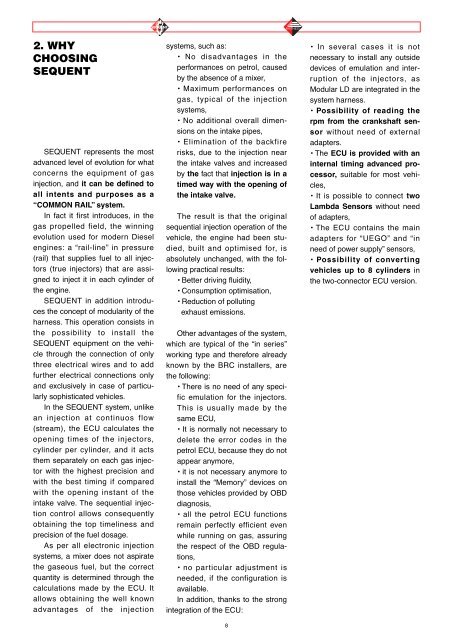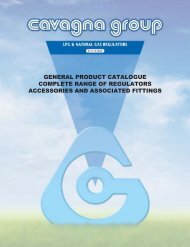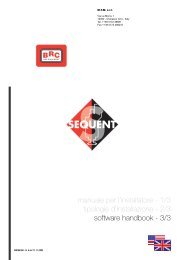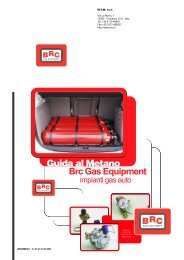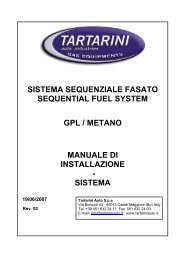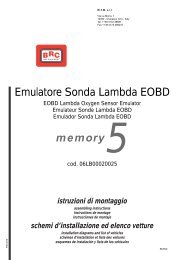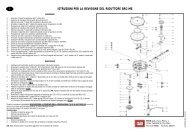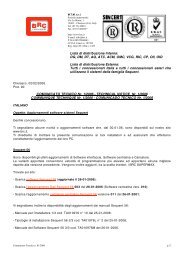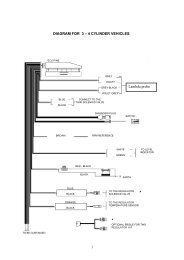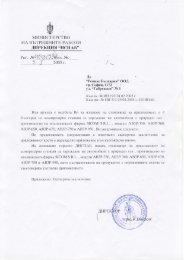Installer's handbook - 1/3 Types of installation - 2/3 Software guide ...
Installer's handbook - 1/3 Types of installation - 2/3 Software guide ...
Installer's handbook - 1/3 Types of installation - 2/3 Software guide ...
You also want an ePaper? Increase the reach of your titles
YUMPU automatically turns print PDFs into web optimized ePapers that Google loves.
2. WHY<br />
CHOOSING<br />
SEQUENT<br />
SEQUENT represents the most<br />
advanced level <strong>of</strong> evolution for what<br />
concerns the equipment <strong>of</strong> gas<br />
injection, and it can be defined to<br />
all intents and purposes as a<br />
“COMMON RAIL” system.<br />
In fact it first introduces, in the<br />
gas propelled field, the winning<br />
evolution used for modern Diesel<br />
engines: a “rail-line” in pressure<br />
(rail) that supplies fuel to all injectors<br />
(true injectors) that are assigned<br />
to inject it in each cylinder <strong>of</strong><br />
the engine.<br />
SEQUENT in addition introduces<br />
the concept <strong>of</strong> modularity <strong>of</strong> the<br />
harness. This operation consists in<br />
the possibility to install the<br />
SEQUENT equipment on the vehicle<br />
through the connection <strong>of</strong> only<br />
three electrical wires and to add<br />
further electrical connections only<br />
and exclusively in case <strong>of</strong> particularly<br />
sophisticated vehicles.<br />
In the SEQUENT system, unlike<br />
an injection at continuos flow<br />
(stream), the ECU calculates the<br />
opening times <strong>of</strong> the injectors,<br />
cylinder per cylinder, and it acts<br />
them separately on each gas injector<br />
with the highest precision and<br />
with the best timing if compared<br />
with the opening instant <strong>of</strong> the<br />
intake valve. The sequential injection<br />
control allows consequently<br />
obtaining the top timeliness and<br />
precision <strong>of</strong> the fuel dosage.<br />
As per all electronic injection<br />
systems, a mixer does not aspirate<br />
the gaseous fuel, but the correct<br />
quantity is determined through the<br />
calculations made by the ECU. It<br />
allows obtaining the well known<br />
advantages <strong>of</strong> the injection<br />
systems, such as:<br />
• No disadvantages in the<br />
performances on petrol, caused<br />
by the absence <strong>of</strong> a mixer,<br />
• Maximum performances on<br />
gas, typical <strong>of</strong> the injection<br />
systems,<br />
• No additional overall dimensions<br />
on the intake pipes,<br />
• Elimination <strong>of</strong> the backfire<br />
risks, due to the injection near<br />
the intake valves and increased<br />
by the fact that injection is in a<br />
timed way with the opening <strong>of</strong><br />
the intake valve.<br />
The result is that the original<br />
sequential injection operation <strong>of</strong> the<br />
vehicle, the engine had been studied,<br />
built and optimised for, is<br />
absolutely unchanged, with the following<br />
practical results:<br />
• Better driving fluidity,<br />
• Consumption optimisation,<br />
• Reduction <strong>of</strong> polluting<br />
exhaust emissions.<br />
Other advantages <strong>of</strong> the system,<br />
which are typical <strong>of</strong> the “in series”<br />
working type and therefore already<br />
known by the BRC installers, are<br />
the following:<br />
• There is no need <strong>of</strong> any specific<br />
emulation for the injectors.<br />
This is usually made by the<br />
same ECU,<br />
• It is normally not necessary to<br />
delete the error codes in the<br />
petrol ECU, because they do not<br />
appear anymore,<br />
• it is not necessary anymore to<br />
install the “Memory” devices on<br />
those vehicles provided by OBD<br />
diagnosis,<br />
• all the petrol ECU functions<br />
remain perfectly efficient even<br />
while running on gas, assuring<br />
the respect <strong>of</strong> the OBD regulations,<br />
• no particular adjustment is<br />
needed, if the configuration is<br />
available.<br />
In addition, thanks to the strong<br />
integration <strong>of</strong> the ECU:<br />
8<br />
• In several cases it is not<br />
necessary to install any outside<br />
devices <strong>of</strong> emulation and interruption<br />
<strong>of</strong> the injectors, as<br />
Modular LD are integrated in the<br />
system harness.<br />
• Possibility <strong>of</strong> reading the<br />
rpm from the crankshaft sensor<br />
without need <strong>of</strong> external<br />
adapters.<br />
• The ECU is provided with an<br />
internal timing advanced processor,<br />
suitable for most vehicles,<br />
• It is possible to connect two<br />
Lambda Sensors without need<br />
<strong>of</strong> adapters,<br />
• The ECU contains the main<br />
adapters for “UEGO” and “in<br />
need <strong>of</strong> power supply” sensors,<br />
• Possibility <strong>of</strong> converting<br />
vehicles up to 8 cylinders in<br />
the two-connector ECU version.


